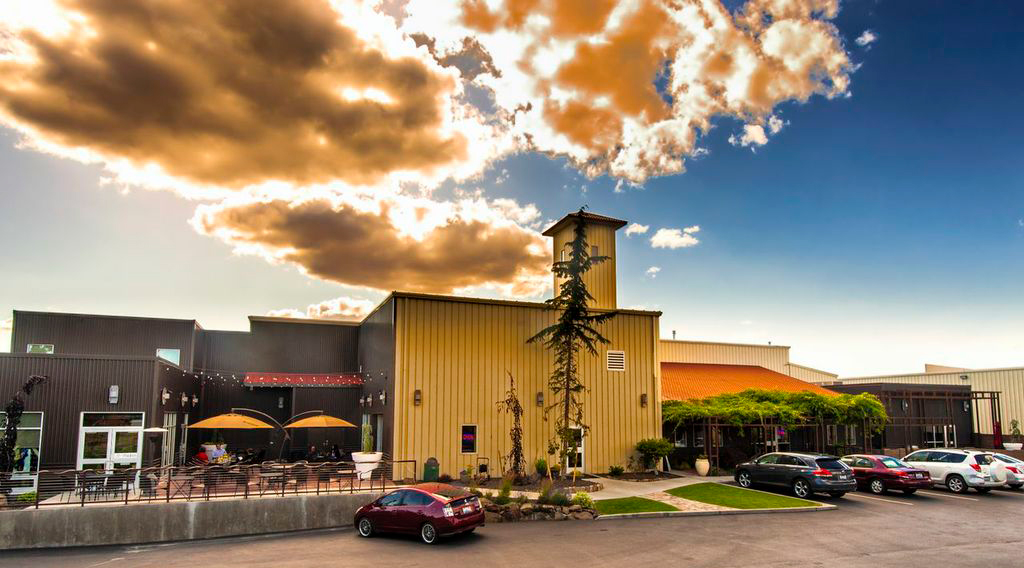Barnard Griffin: Winemaker Rob Griffin has taken the road
less traveled — and that has made all the difference
Griffin and his wife Deborah Barnard have created a well-loved brand
that is now into its second generation and a fourth decade.
By Ken Robertson
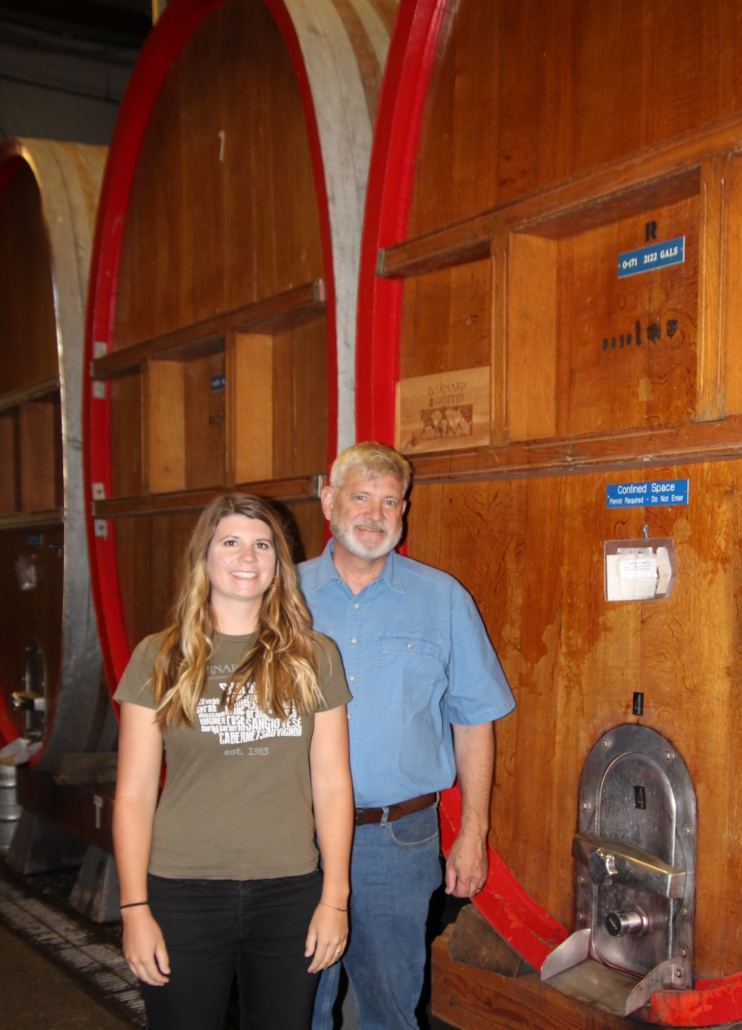
Rob Griffin and his daughter, Megan Hughes, make good use of several huge German Oak wine barrels that Rob bought in 2002. The 14-foot-tall barrels hold 1,700 gallons of wine (the equivalent of 700 cases) and since they are no longer imparting oak character, they are now used as storage vessels. Photo by Ivory Leininger.
When Rob Griffin arrived in the Tri-Cities in 1977, he knew he was coming to a new Wild West of winemaking in the nation’s Northwest corner. But he had a plan.
Within a few years, he aimed to gather some important experience to add to his resumé, which included a highly desirable degree from the University of California-Davis, where he’d enrolled at the tender age of 17, and then he would take his next job jump — ideally to a prestigious winery back in his home state.
It didn’t exactly turn out that way. His first summer at Preston Wine Cellars north of Pasco, WA., produced some excellent Chardonnay grapes — and a year later the wine he crafted from them won a major award in the Northwest’s most acclaimed wine competition in Seattle. A couple years later, Pinot Noir from the 1978 vintage shocked Oregon’s premium Pinot Noir competition and won its top award.
Griffin’s then-boss, the late Bill Preston, used to joke that among other things, it also got Washington wines, once welcome at the competition, banned. In following years, only Oregon wines could compete. Whether Preston’s story was true or not, the twin wins did shine a light on the 20-something who had become Washington’s newest star winemaker.
It was a heady time for Griffin. “I moved up here on my own nickel on a salary that I could barely afford to rent an apartment in Kennewick,” he recalls.
But over his first few years, as Washington’s wine community was expanding and gaining more attention regionally and nationally, Rob Griffin’s winemaking skills were earning him a spot among its rising stars.
Chateau Ste. Michelle, the big kid on the block in Northwest wine since the late 1960s, was showing that Washington state could do lots more than produce fine Riesling. Its 1975 and 1977 Cabernet Sauvignons and an ensuing string of high-quality Merlots were surprising the nation’s wine writers. Suddenly, they were realizing, Washington could make stellar red wines that might match the Ste. Michelle Rieslings, which had been turning heads since the early 1970s.
Tom Stockley, the state’s first newspaper wine columnist at the Seattle Times, was joined by the Tri-City Herald’s Bob Woehler in 1978 and soon afterward by the Yakima Herald-Republic’s Stan Clarke. All three were writing regularly about the state’s vineyards and wines and their writing and the awards those wines won were prompting California, the nation’s leading grape grower and wine producer, to take notice.
At the same time, Oregon Pinot Noir was also grabbing headlines and prompting even Burgundians to take notice.
By 1982, Griffin decided his seven years at Preston had earned him the reputation, experience and contacts to try to enter the Northwest wine world with his own label. But Bill Preston would not grant him free rein to make wine for both Preston Cellars and for his own winery.
So, in 1983, Griffin moved to Hogue Cellars, where he would remain until 1991. There, total yearly production reached 30,000 gallons while he was winemaker, and, partly because of a lean staff, he learned a wider range of skills that would help his own label prosper.
“It was great experience,” he said. “Mike Hogue was a quick learner and a great businessman and really intuitive about people and business.”
At the same time, Griffin launched his own label, Barnard Griffin, drawing its name half from his wife, Deborah Barnard, and, and half from his own last name. Their combination created a lasting, well-loved brand in the Northwest that is now into its second generation of winemaking and a fourth decade.
There were lean times in the beginning. Griffin recalls he made his first wines using “borrowed grapes and as many French oak barrels as I could buy” in rented warehouse space. His longtime friend Maury Balcom, who remains a grape supplier to this day, “loaned us the fruit.”
From that frugal start, Griffin began producing award winners under both the Hogue and Barnard Griffin labels, and with both red and white wines.
In those early years, his Rieslings, Fumé Blancs and Chardonnays provided early cash flow so the reds could spend time in oak before earning their keep and providing a bit bigger payback.
Griffin said he and Deb also developed a lasting distaste for debt and worked hard to pay for everything without borrowing money as they continued to build their winery’s reputation and expand their outreach to obtain a share of the region’s best grapes. By 1996, their philosophy was paying off well enough to begin building their winery on Tulip Lane in Richland, a street named for their iconic label of yellow and red tulips. They moved into it in 1997.
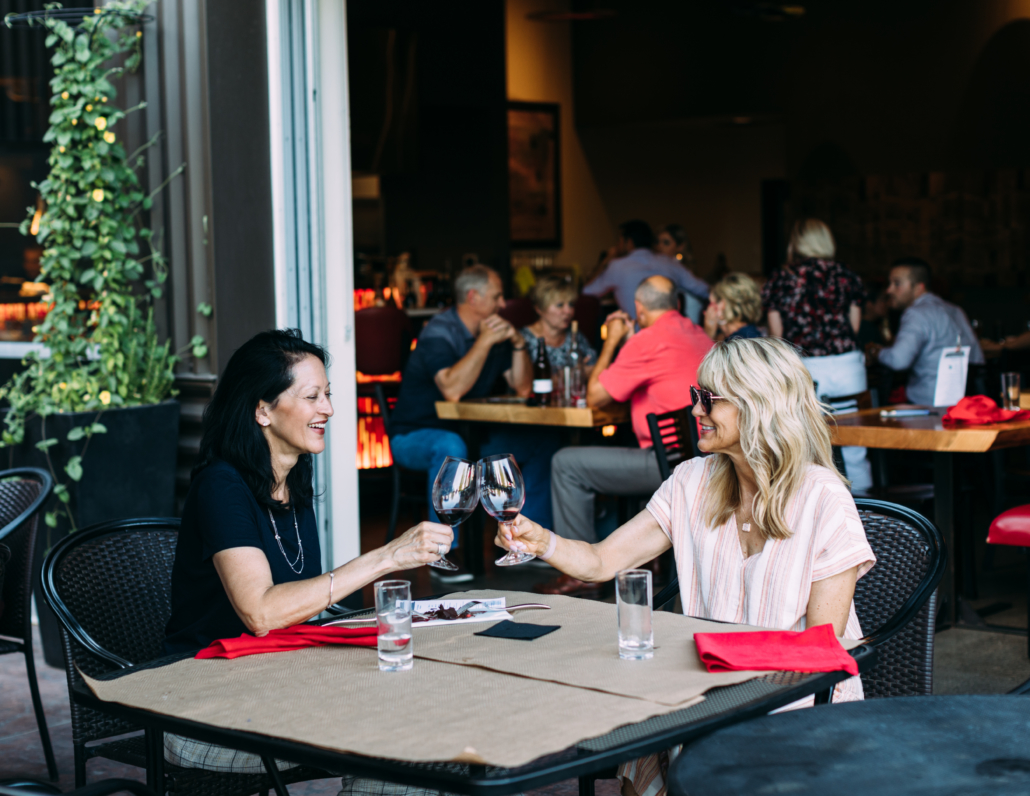
During the summer months, patrons of Barnard Griffin’s on-site restaurant called “The Kitchen” overflow onto the eatery’s outside patio. The winery’s limited production of sparkling Albariño is available only at The Kitchen in glass pours.
Located just off Columbia Park Trail, the former route of U.S. Highway 12, on the south the winery is bounded by J. Bookwalter Winery, founded in 1982 by Jerry and Jean Bookwalter, and now led by their son John.
Starting in 1976, Jerry Bookwalter helped plant Sagemoor, Bacchus and Dionysus Vineyards north of Pasco, the source of some of Washington’s finest grapes by the early 1980s. And the elder Bookwalter later managed the famed Conner Lee Vineyard.
In the early years, Chardonnay was Barnard Griffin’s biggest seller and it remains an important part of their wine portfolio, produced in two versions, one under their recently adopted Griffin label, and a second under their reserve tier.
Over the ensuing decades, Barnard Griffin wines have regularly won state, regional and national honors for quality. For example, the 2008 Riesling was named by Wine Spectator as one of the 100 most exciting wines of 2009. That same year, Wine Press Northwest Magazine awarded platinum medals to Barnard Griffin 2006 Merlot, 2007 Cabernet Sauvignon and 2008 Rosé of Sangiovese. And at the 2010 San Francisco Chronicle Wine Competition, the nation’s largest, its 2009 Rosé of Sangiovese and 2008 Syrah both won gold medals.
Griffin’s Rosé of Sangiovese has been remarkably consistent over more than a decade. In a stretch spanning from 2006 to 2019, it’s won best rosé in San Francisco six times and won gold all but one year. And though that one year of Sangiovese didn’t win in San Francisco, it did capture gold medals in two other competitions.
The Sangiovese has become so popular that it surpassed Griffin’s Chardonnay four years ago and became his biggest seller and now is about 25% of the winery’s total production. Along the way, it’s been a consistent winner at Wine Press Northwest’s annual Platinum competition, which brings together each year’s gold medal winners from throughout the Northwest. And it has helped Barnard Griffin win 23 Platinum medals, which ranks fourth among Washington wineries.
Ever since the winery building opened, Rob and Deborah have been busy expanding and innovating. The winery side of their operation includes several reserve-tier offerings annually and many of the interesting newcomers to Washington’s vineyards, including Viognier, Roussanne, Albariño, Mourvedre and Grenache.
From the varieties added over the past decade, Rob is particularly impressed by Albariño from Crawford Vineyard, which he describes as “a lovely variety” that’s exquisitely crisp and lean. Among the popular additions are “Côtes du Rob” red and white blends. The red is a “GSM” blend of Grenache, Syrah and Mourvedre; the latest release of the white is 85% Viognier and 15% Roussanne.
“I’m a blender,” Rob said. “I’m not about only one little corner” of the state. He consequently draws his grapes from nearly every corner of Washington wine country, mostly focusing on the state’s largest American Viticultural Area, the Columbia Valley.
“In my opinion, the right Columbia Valley blend can be as good as anything,” he added. “The best wines are coming out of more than one location.” His most exclusive release was BG’s top-flight Centurion label, a limited production wine first offered in 2018 to only a few hundred longtime lovers of Barnard Griffin wines.
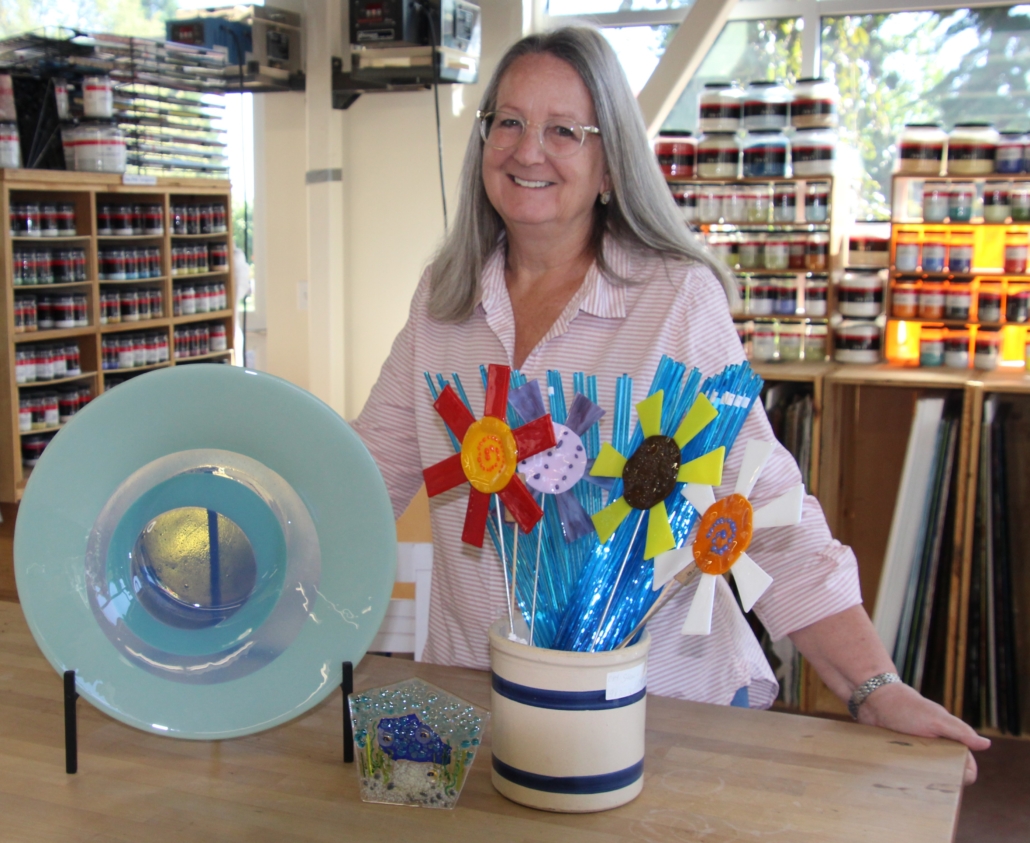
In a building adjacent to Barnard Griffin Winery, you’ll find Deborah Barnard pursuing her longtime passion for making fused glass art pieces in her studio called “dbSTUDIO.” The studio enjoys a brisk traffic of students, instructors and visiting glass artists. Photo by Ivory Leininger.
After Deborah began pursuing her longtime passion for making fused glass, db STUDIO, where she is the resident artist, was added on the winery building’s south side and enjoys a brisk traffic of students, instructors and visiting glass artists. Some of her accomplished students also offer classes there.
Deborah’s glass art hangs from the ceiling of the restaurant located at Barnard Griffin called “The Kitchen” and is showcased and sold at the winery. The bistro-style restaurant serves regionally sourced, innovative cuisine thoughtfully paired with an array of BG wines, craft brews and other beverages.
On weekends, local musicians are regularly featured, drawing crowds that enjoy the fine food and superb wines. And the winery also is host for special events, including receptions and birthdays, at its event center.
But what Rob and Deb are perhaps most proud of is that Barnard Griffin has become a second-generation business and a third generation is in the wings. Their daughter Megan Hughes, who graduated from Washington State University in Pullman in 2010 with a degree in enology and viticulture, joined the family winery soon after graduation.
After working every aspect of the business, Megan oversees production of Barnard Griffin’s white wine lineup, including a limited production of sparkling Albariño available only at The Kitchen in glass pours. She and Rob both talk enthusiastically about another pending project, a sparkling Chardonnay residing in one of their tanks, release date so far undecided. Her Chardonnays, Sauvignon Blancs, Albariños and Viogniers are all impressive and several have won gold medals. She says she truly enjoys working at her parents’ operation.
“I do love it. I don’t think there are many things that allow you to do so many things that are so different,” she added. “It’s cool to know you’re adding something to people’s experience. You get to be part of people’s everyday moments. There’s something magical.”
Deb and Rob’s other daughter, Elise, also a WSU grad, managed the launch of The Kitchen when it first opened but now is busy raising the winery’s first grandchildren.
What lies ahead? Rob plans to continue leading the wine-making team, which also includes his longtime assistant winemaker Mickey French, who oversees BG’s red wines. But Rob sees a day when he’ll step away from the every-day bustle. In 42-plus years as a winemaker and winery owner, he has, as he said, “seen the whole industry play out.”
“My vision was making wine people can afford to buy and making it well. I don’t concede quality to anybody,” he added. He can check that off his list.
And, ultimately, he and Deb also have nurtured a parallel vision. “We always hoped we could leave a legacy that the kids could make bigger and better.”
Barnard Griffin Winery is located at 878 Tulip Lane. Richland, WA. 99352. Phone: (509) 627-0266. For information about joining the winery’s wine club, visit: www.barnardgriffin.com
EDITOR’S NOTE: Ken Robertson, retired executive editor of the Tri-City Herald, has been sipping and writing about Washington wine since 1977.
Barnard Griffin enters canned wine arena with three white wines
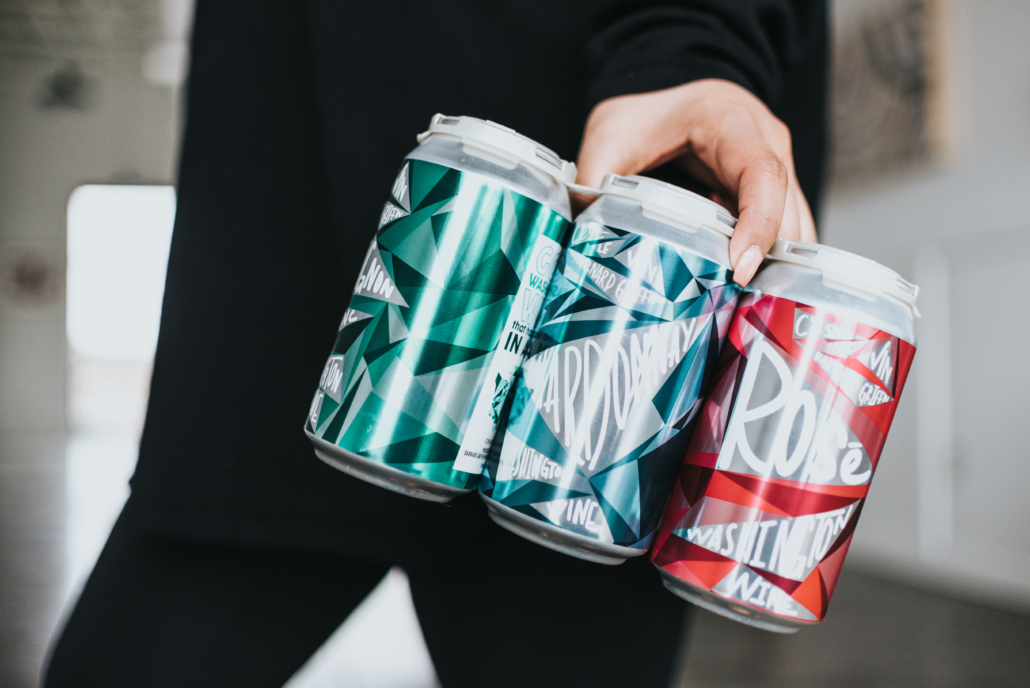
Barnard Griffin just recently entered the canned wine market with three white wines — a Sauvignon Blanc, a Chardonnay and a Rosé of Sangiovese.
Now that wine lovers have just about embraced the concept of screwcap wines, an even more startling idea is re-emerging — canned wines.
Before turning your nose up at the idea, try sampling some. Wine judges around the Northwest, known to be skeptical about such things, have been judging some of our region’s canned wines during blind tastings. And, they’ve been pleasantly surprised.
At two judgings where I worked earlier this year, maybe even stunned would not be too strong a word for the judges’ reactions. At both events, canned wines won gold medals. One was from Barnard Griffin’s aluminum can label, C’est le Vin Barnard Griffin.
It’s a variation on the winery’s justifiably famous Rosé of Sangiovese. According to winemaker Rob Griffin and his white-wine winemaker, daughter Megan Hughes, the three wines they have released so far — a Sauvignon Blanc, a Chardonnay and the Rosé of Sangiovese — differ slightly from their bottled versions.
All have a little bit of spritz because they are carbonated to deliver what’s expected from a canned beverage — a dash of bubbles. And since the CO2 dissolves in the wine, producing carbonic acid, the wines for the can are made a bit less dry to balance out the acidity and to meet another expectation of the canned beverage customer: A drink from a can should have a little sweetness, they said.
So far, Hughes says they’re pleased with the public reception, especially from the younger wine crowd, which seems to embrace the concept willingly. “I think millennials may be the easiest market,” she said. “What’s happening now is different.”
All the wine that’s being put into cans is part of a planned expansion. Barnard Griffin aims to add another 10% to its total production by January 2020. So far, their plans don’t extend to reds. Red wines, when canned, “behave very strangely,” Hughes said. For now, she’ll leave the reds to others.
But it’s clear that, for many, the concept of an easily portable container that holds two full glass pours for a picnic, the pool or the beach — anywhere that a glass bottle might be a liability — is definitely attractive.

